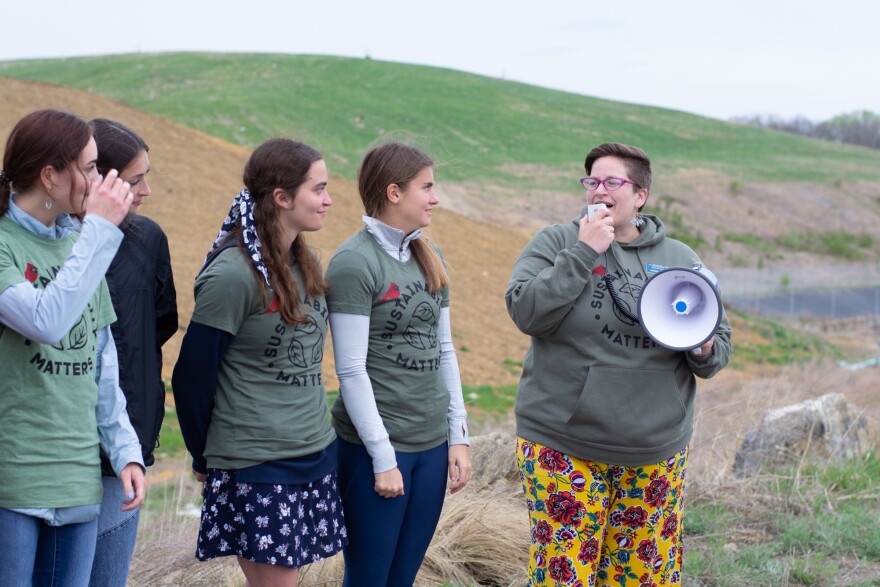A local campaign to plant native pollinator meadows on landfills marked a big milestone on Thursday, April 21 — the day before Earth Day. WMRA's Randi B. Hagi reports.

ATTENDEES CHANTING: Grow, seeds, grow!
At the Shenandoah County Landfill in Edinburg on Thursday, about three dozen people milled around at lunchtime, munching on wraps and fruit. They watched as a truck in the distance sprayed a mixture of water, mulch, and wildflower seeds onto a mountain of trash that's been covered over with clay and topsoil.

SARI CARP: This is actually the first time that we are planting directly on a trash cell, so it's an important step for the project.
Sari Carp is the founder and executive director of the organization Sustainability Matters. This project, called "Making Trash Bloom," has been four years in the making.
CARP: So it's being hydroseeded by this giant machine. It's actually, they are up at the top of the very steep hill that is full of trash, and they are spraying downward in this kind of green goo – we have a mixture of native seeds.
Two years ago, they sowed wildflower seeds on a smaller, flatter test plot at the landfill.

CARP: I think that the Shenandoah County Landfill, which is of course where this piloted, where it began – thought we were crazy when I first came up with the idea.
The operations manager of the landfill, Brad Dellinger, said he was interested in the idea because –
BRAD DELLINGER: We were looking for something that would keep us from mowing.
Typically, when a trash cell – which Dellinger described as a big soup bowl – gets full –
DELLINGER: We go into post-closure – that's when we're all done, and basically it's three feet of clay on top of the trash, then there's a sheet that goes up over it – it's like a burrito. We just wrap it.

Then it would get covered in topsoil and grass seed. That's what's been done to the landfill's other three closed cells. Dellinger has had a hand in the creation of each one.
DELLINGER: My life's trash!
His relationship with the place goes back five decades. When he was nine years old, he helped out with the family business of hauling other people's trash to the dump. Eventually, the county asked if he'd "babysit" the landfill, as he puts it.

For this project, he said they were able to take the same equipment they normally use to hydroseed the grass and fill it with the wildflower mixture.
DELLINGER: It's about $400 worth of seed, so hopefully it pops up and blooms!
There are about two dozen different types of seed in the mix.
HANNAH BEMENT: Some of our common native meadow plants are in there, like Monarda fistulosa, which is wild bergamot or bee balm. It's this amazing, Dr. Seuss-looking bloom that is just an absolute favorite of butterflies and bees and hummingbirds and a great nectar source for our native pollinators.

Hannah Bement teaches biology at the Mountain Vista Governor's School, which has locations in Middletown and Warrenton. Some of her high school students will be monitoring the pollinator meadow as it grows.
BEMENT: They are going to be playing the role of ecologists for this project. They'll be coming in and surveying to see which seeds germinate, how long does it take for them to bloom, what pollinators come in and make use of them, as well as other environmental characteristics that are relevant to landfill managers as they decide whether this program is a good fit for their landfills. So things like, how do these native plants change the way water moves across the landfill cell? Or how much water percolates down into the trash's leachate?
This trash heap is just the beginning – Sustainability Matters has agreements with landfills in Rappahannock and Fairfax counties to plant there, too. Sonia Zamborsky is the group's communications director.
SONIA ZAMBORSKY: We have one grant that we've gotten from the Community Foundation of Northern Virginia, and we have several others that we're in the running for. And so we will be planting on the closed landfill at the I-66 transfer station which is in Fairfax … The idea is that this becomes a nationwide project – possibly even worldwide!
To learn more, visit their website at sustainabilitymatters.earth.


